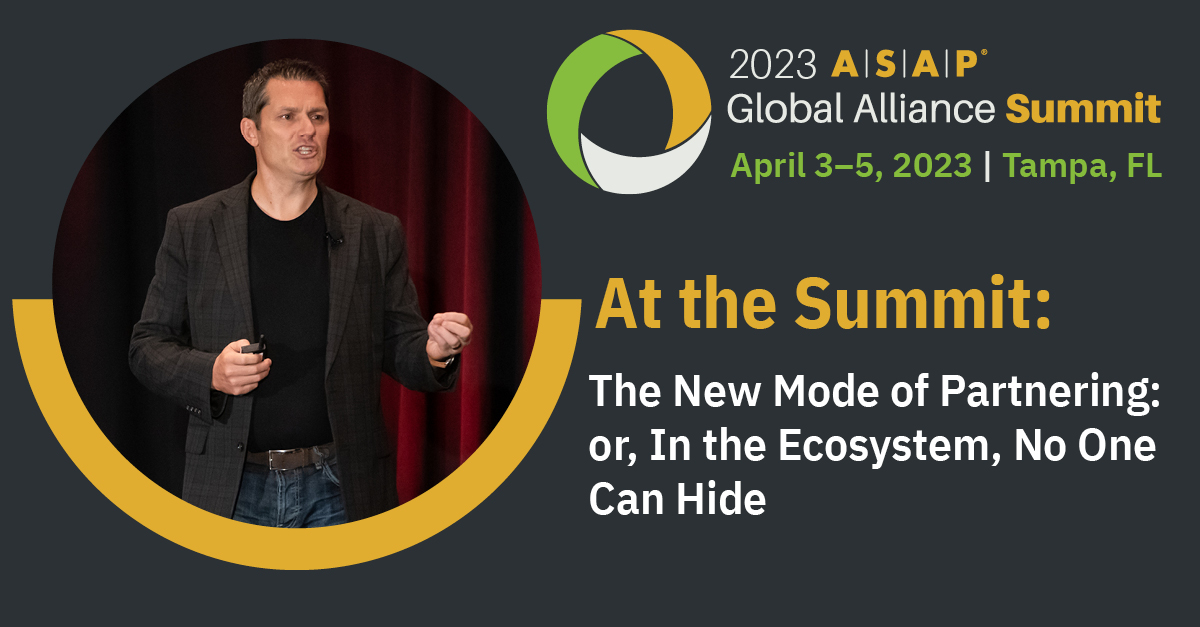The New Mode of Partnering: or, In the Ecosystem, No One Can Hide
One of the perennial fascinations about listening to ASAP audience favorite Jay McBain, chief analyst of ecosystems, channels, and alliances for Canalys, is hearing his predictions. Or rather, comprehending the rate at which he delivers them—and the even more rapid rate at which the predictions he’s been making are steadily coming true.
Once again McBain provided plenty of food for thought in his ASAP Global Alliance Summit keynote address, “Future of Alliances: Forecasting the People, Programs, and Technology That Will Drive the Next Decade of Partnering.”
What’s changed in the last few years? What hasn’t? Better to ask, what’s changed since McBain last spoke to us here in Tampa a year ago?
Batteries Included
Answer: Everything. Or if it hasn’t, it’s in the process. You’re already buying everything as a subscription. Your car is fast becoming “a battery surrounded by sheet metal.” The big tech companies are all hiring ecosystem chiefs, who report to the CEO.
And there’s more. The future of alliances? It’s hurtling toward us at breakneck speed, just like that oncoming car (powered by Apple CarPlay).
McBain presented a Top 10 Trends à la David Letterman, but we’ll just dip our toes in the water here and there and shake them off once in a while. Among the nuggets we panned from McBain’s stream of consciousness:
In a $94 trillion world economy, 75 percent of world trade flows indirectly. That means through channels, partnerships, and ecosystems. Given the shocks of the pandemic, war, and inflation, it turns out that channel partners by and large are doing better than the vendors whose wares they sell. They’ve figured out how to add value by selling services, integrations, retention, and more that are wrapped around the product or solution. And many of them aren’t actually selling—they’re influencing or advising or assisting at various stages of the customer journey, making them nontransactional.
One If by Land, Two If by Sea…Hey, It’s Kim Kardashian!
According to a CRN Channel Chiefs 2023 survey, 48 percent of channel chiefs now state that they are “in ecosystem mode.” “Whether they are or not,” McBain observed, “is a discussion for another time. They’re not.” But they think they are, and they think that’s where they’re bound to go. (And then there’s ecosystem chiefs in ecosystem mode: McBain noted that some 12,000 people have “ecosystem” in their titles on LinkedIn.)
The average customer midsize or larger has seven partners they work with and trust along the journey—some of them nontransactional. So there’s more than one “trusted advisor,” and in fact there are a number of influencers that play a role. “Who are the 100 mini–Kim Kardashians?” McBain asked. (He also noted that in 1776 Boston, the greatest “superconnector” was a silversmith named Paul Revere; this came from Malcolm Gladwell’s bestseller The Tipping Point.)
The B2B buying cycle now looks more like B2C. Customers tend to want it, and Wall Street wants it even more. The purchase just means the first 30 days with the customer, and getting them to the dance, in McBain’s parlance. After that, you’ve got to get them dancing and keep them on the dance floor over many boogie nights.
Magic Numbers and Peanut Butter
Online marketplaces are another area of growth surges—and it’s “not just a Peloton moment,” according to McBain. The average cloud solution has a “magic number” of seven layers, and companies like Microsoft are “spreading money around like peanut butter,” trying to move resources to the places and partners that will do the most good.
Like many others in this realm, distributors have morphed too, doing battle to take on the role of ecosystem orchestrators. In fact, distributors may be some of the biggest companies many have never heard of, but now they’re “coming out of hiding—because in the ecosystem, nobody hides.”
It’s a brave new world, for sure, with so much in it. With every company becoming a tech company, and “every company now talking in multiplier language,” there’s money to be made for those who know how to leverage the right skills. And increasingly, per McBain, those aren’t purely transactional channel reseller skills, but the more nuanced big-picture attributes of alliance and partnering and ecosystem professionals. They’re the ones poised to take the stage in the next economic phase of development.
“We’ve turned the corner, and the decade of ecosystems is quickly gaining traction,” McBain summarized. “Every line of business executive is spending half their time talking tech. This is changing partnering for all of us, in every industry. There’s a new mode of partnering.”
Want to follow along and keep up with what’s going on at the Summit? Be sure to keep checking this space for our continuing coverage from Tampa.

